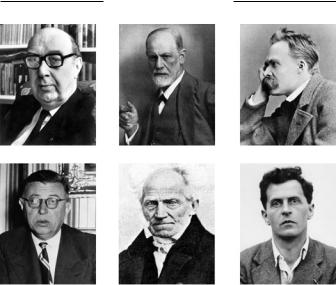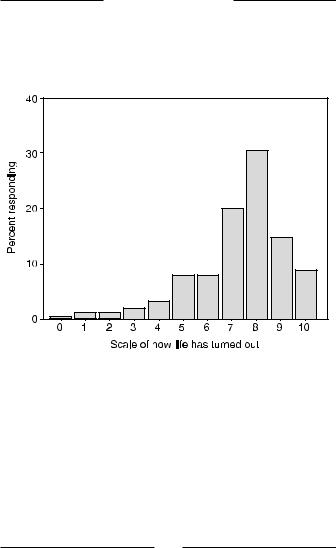
Books on Happiness / Happiness_ The Science Behind Your Smile
.pdf
COMFORT AND JOY
that we might often be tempted to fall for things that provide either a high peak of joy or remain joyful right to the end, when in fact we would maximize the amount of pleasure in our lives if we chose things that went on for longer at a lower level of intensity. The former type of thing—a big night out, for example—might make a greater psychological impact in terms of the average of peak and end, but the latter—a good weighty novel, or a new skill acquired—might provide more lasting happiness if all its moments were added up.
Kahneman uses results such as these to draw a distinction between objective and subjective happiness. This seems like a strange distinction to draw, when all happiness is intrinsically about subjective experience. However, what Kahneman means is that level one experiences provide a kind of raw data of happiness, namely how good or bad we feel from moment to moment. If we want to make a level two judgement of how happy we have been, we should simply sum up this level one data, which we could in principle collect by having a meter running in our pocket that we flipped every time we made a transition between feeling good and feeling bad (a hedonimeter!) The meter would provide an objective summary of our subjective experience.
What we actually do when we try to consider how
42

COMFORT AND JOY
happy we are, have been, or will be, is something much cruder than the objective summary of level one experiences. We make a kind of best guess, or subjective estimate of our subjective experience. The guess is biased by things like the peak-end rule, our current mood, the standard of comparison we are making, and our failure to predict our own adaptation. This means we may end up with an inaccurate picture of the net effects of our behaviour on our happiness, and choose things that don’t in fact make us happier. I will argue later in the book that these effects are probably not faults in the happiness programme; they are the way that it is designed. That is, the purpose of the happiness programme in the human mind is not to increase human happiness; it is to keep us striving. That is why it tells us so clearly that if we just had a £30,000 salary, we would be much happier than we are now on £20,000, but as soon as we achieve that goal, whispers that perhaps it was actually closer to £40,000 that is really needed to guarantee lasting bliss.
The effects we have seen in this chapter—particularly comparison and adaptation—have huge implications for happiness, as well as hedonics. They mean that when people tell us how happy they are, we may be partly picking up the psychological framing of the question rather than the objective circumstances of their
43

COMFORT AND JOY
lives. They also mean that great unhappiness in life is often a result of thinking about things in the wrong way rather than objective circumstances; failing to discount other reasons for moods, making the wrong comparisons, or dwelling on the past in the wrong way. They also raise questions that we have to confront as a society. For example, what does it mean for our satisfaction with our lives that the magazines on every news stand are full of airbrushed images of lipo-sucked supermodels, and tales of men who ski off glaciers with world leaders, and list their hobbies as judo, chess, and the Kama Sutra (in the original Sanskrit, of course)? With all these questions in mind, we will now turn to survey evidence about how happy people actually are.
44

2
Bread and circuses
‘ f the immediate purpose of our existence is not Isuffering, then our existence is the most illadapted to its purpose in the world’, wrote Arthur Schopenhauer in a late essay entitled On the suffering of the world. Misfortune and unhappiness, he argues, are the rule rather than the exception in life: ‘Work, worry, toil and trouble are indeed the lot of almost all men
their whole life long.’
It is true that human beings often have a great deal to worry about, from financial uncertainty, to poor health, to unrequited love, to the disappointment of not realizing life-long dreams. And Schopenhauer certainly has some very interesting insights into the logic of happiness. However, here, he is making an empirical claim; that is, that most people are generally pretty unhappy.
Schopenhauer stands at the head of a line of great European thinkers and artists who were happiness pessimists (Fig. 2.1). That is, they believed that the conditions
45

BREAD AND CIRCUSES
necessary for happiness are extremely hard to attain, usually because of some profound gap between what we want and what we can actually have. For example, the knowledge of our own death, society’s repression of our drives, or the cruel and illusory psychology of desire, put us in a state of eternal angst. The world the pessimists described was one in which most people are basically unhappy, and will remain so either forever, or until some kind of unlikely utopia can be constructed (which may take even longer).
An alternative hypothesis is the contention that most people, by and large, are satisfied with their lot. As Roman satirist Juvenal wrote: ‘the public has long since cast off its cares . . . and longs eagerly for just two things: bread and circuses!’ Now Juvenal was generally a happiness pessimist, believing like the good Stoic he was that people were often made miserable by the vanity of their own desires. In this particular passage, though, he is apparently making the opposite claim; that if asked, most people whose basic needs for sustenance and minimal entertainment are met would say that they were happy.
We might call these two positions the Sturm und Drang hypothesis (‘want and boredom are . . . the twin poles of human life’) and the bread and circuses hypothesis (‘the public has long since cast off its cares’). If we take them
46

BREAD AND CIRCUSES
Fig. 2.1 Grumpy old men: Larkin, Freud, Nietzsche, Sartre, Schopenhauer, Wittgenstein. Many great European intellectuals have been happiness pessimists. Match the quotations with the photographs. (Answers in the notes at the back.)
Quotations:
1One feels inclined to say that the intention that man should be happy is not included in the plan of Creation.
2 The existentialist says at once that man is in anguish.
3Throughout the ages the wisest of men have passed the same judgement of life: it is no good.
4I don’t know why we are here, but I’m pretty sure that it is not in order to enjoy ourselves.
5Today it is bad, and day by day it will get worse—until at last the worst of all arrives.
6Man hands on misery to man/It deepens like a coastal shelf/ Get out as early as you can/And don’t have any kids yourself.

BREAD AND CIRCUSES
as descriptive hypotheses (that is, ideas about how the world is, not how it should be), then it becomes a simple empirical matter to find out which one is right.
The UK periodically carries out large-scale studies of a cross-section of its population. For example, in what is known as the National Child Development Study (NCDS), all the children born between March 3rd and March 9th 1958 were studied extensively. Every detail about their births, family backgrounds, school attainment, and health has been recorded from 1958 to the present (they are now in their forties). Every few years, those that can be traced have been interviewed about many aspects of their lives. The archives of the NCDS now contain literally thousands of data on each of the cohort members, and thus it offers a unique picture of how a whole slice of the population develops, thinks, and behaves. As well as allowing researchers to answer questions about themes specific to the UK in this particular historical epoch, the breadth and detail of the data mean that universal questions about topics like health, marriage, and happiness can be investigated. The results confirm and expand what we know from many smaller studies from different parts of the world.
The NCDS participants have often been asked questions relating to happiness. For example, in 2000, at the
48

BREAD AND CIRCUSES
mid-life crisis peak age of 42, they were asked to indicate their satisfaction with how their lives had turned out so far, on a scale of 1 to 10. The results are stunning (Fig. 2.2). More than 90% of the 11,269 respondents chose 5 or above. More than half of them chose 8, 9, or 10, with 8 the most frequent choice overall.
These results are very much in keeping with those of dozens of other surveys in many different countries. When asked, most people say that they are happy or very happy, and this result is robust as regards age, place, sex, or different ways of asking the question. Just as in Lake Wobegon, pretty much everyone claims above average levels of satisfaction with their lives. As a description of the general condition of the populace, the Sturm und Drang hypothesis doesn’t really get past first base.
Of course, the studies I have quoted, and most psychological investigations, are carried out in extremely affluent populations, where many of the pains and fears that must have loomed large in historical times have been brought under control. Perhaps if we were to survey a population that lacked modern luxury, we would find more evidence of human misery.
There are by now several large international comparison studies, and interestingly there are significant differences between nations. We will turn to these in
49

BREAD AND CIRCUSES
Fig. 2.2 Distribution of responses to the question of how life has turned out, on a scale of 1 to 10, from the 2000 sweep of the National Child Development Study.
50

BREAD AND CIRCUSES
the next chapter, but here it is worthy of note that the tendency is still towards the positive. In none of 42 countries surveyed in the early 1990s, for example, is the average as low as 5.0, the mid-point on a ten-point scale (Table 2.1). The spectrum goes from the lugubrious Bulgarians with an average satisfaction of 5.03, to the positively nauseating Swiss with an average of 8.39 (which means either very few people are discontented, or some people were giving answers higher than 10). It is also worthy of note that all the averages lower than 6 are countries which had just undergone the rapid transition from communism. This destabilization was
Table 2.1 Average life satisfaction (on a ten point scale) for a large sample of individuals from a selection of countries.
Bulgaria |
5.03 |
Italy |
7.24 |
Russia |
5.37 |
Argentina |
7.25 |
Romania |
5.88 |
Brazil |
7.39 |
Hungary |
6.03 |
Mexico |
7.41 |
India |
6.21 |
United Kingdom |
7.48 |
Czech Republic |
6.4 |
Chile |
7.55 |
Nigeria |
6.4 |
Finland |
7.68 |
Japan |
6.53 |
United States |
7.71 |
South Korea |
6.69 |
Ireland |
7.87 |
France |
6.76 |
Sweden |
8.02 |
China |
7.05 |
Denmark |
8.16 |
Spain |
7.13 |
Switzerland |
8.39 |
|
|
|
|
51
